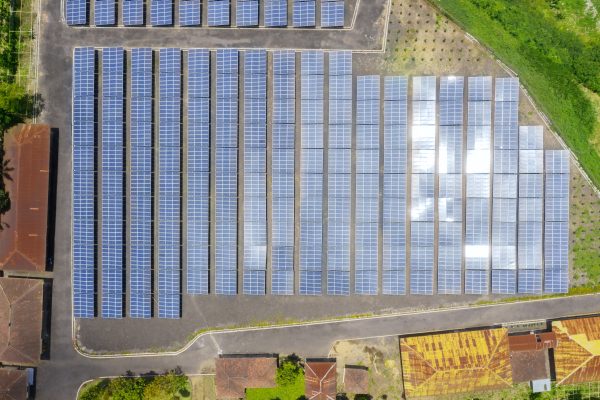Copyright thediplomat

Many observers praised China's pledge to peak its carbon emissions by 2030 and reach carbon neutrality by 2060 as a historic commitment for global climate governance. However, much less attention was given to what was happening within the nation's own industrial machinery. China's renewable energy industry has expanded so quickly after 20 years of state-driven growth that it now faces the paradox of its own success. China's installed renewable capacity reached an astounding 3,348 gigawatts (GW) by 2024, surpassing the combined electricity generation of Europe and the United States. Within this total, 887 GW came from solar energy and another 521 GW from wind, with additional projects already underway. The country’s manufacturing output, however, far outpaces domestic demand: its factories are capable of producing over 861 GW of solar modules annually, a volume that the national grid cannot yet absorb. This remarkable industrial scale-up has produced what might be described as a green surplus: an abundance of renewable technologies that the domestic system struggles to utilize efficiently. Grid bottlenecks, curtailment rates reaching up to 9 percent in certain provinces, and sluggish demand have left entire inventories of solar panels warehoused and idle. What appears on the surface as a technical challenge is, in essence, a political economy dilemma. When the world’s largest producer of green technology can no longer sell its output at home, the question arises: where does this surplus go? From Domestic Boom to Global Spillover China has gradually turned its excess production into an outward-oriented development strategy that exports goods and its institutional model of green industrialization over the past decade. The Belt and Road Initiative (BRI) and Asian Infrastructure Investment Bank (AIIB) are financing this transnational expansion by directing capital and equipment to the Global South. In this process, China is effectively undergoing what some scholars have called a “second industrial revolution.” The first revolution internationalized the production of steel and cement; the second sends out solar modules, wind turbines, and battery systems. According to the “China’s Global Power” database, over 68 percent of China's overseas generation capacity investments were directed toward solar and wind renewable energy projects by 2022-2023. Southeast Asia, in particular, has emerged as a primary destination, absorbing more than 31 percent of China’s total renewable energy investments abroad. Over the past decade, China has led public clean energy investment, contributing more than $2.7 billion into ASEAN clean energy markets. At the center of this regional transformation lies Indonesia. Indonesia: The Perfect Outlet With more than 278 million people scattered across 17,000 islands, Indonesia offers both a massive energy market and a logistical maze. Under the National Electricity Master Plan (RUKN), electricity demand in Indonesia is projected to increase almost four times in the next 35 years – from 482 terawatt-hours (TWh) in 2024 to almost 1,813 TWh by 2060. For China, that’s precisely the kind of growing market its renewable surplus needs: resource-rich, rapidly urbanizing, and still building the power systems that much of the developed world already takes for granted. Jakarta’s ambitions match the moment. The government has pledged to achieve net-zero emissions by 2060 and aims for 52 percent of its energy mix to come from renewables by 2044. Yet structural constraints persist. The country’s grid remains outdated, domestic financing is limited, and its solar manufacturing capacity, barely exceeding 1 GW annually, cannot possibly meet future demand on its own. Against this backdrop, Chinese engagement has intensified. The two nations inked 11 agreements totaling $12.6 billion in 2023 alone, the majority of which had to do with electric vehicles and renewable energy. This degree of collaboration has never been seen in Indonesia's power industry. A case in point is the Cirata Floating Solar Power Plant, the largest of its kind in Southeast Asia. The project – built by PowerChina and Indonesia’s state utility Perusahaan Listrik Negara (PLN), with a U$100 million loan from the China Development Bank – went online in 2023. It now adds 145 megawatts (MW) to the grid, enough to supply about 50,000 homes and reduce carbon emissions by more than 200,000 tons a year. China’s presence extends beyond solar infrastructure. The State Grid Corporation of China (SGCC) has partnered with PLN to modernize Indonesia’s transmission network, including ambitious plans for high-voltage direct current (HVDC) interconnections linking Java, Sumatra, and Kalimantan. Meanwhile, in Sulawesi, Chinese investment exceeding $30 billion in nickel downstream processing has transformed the region into a global hub for electric vehicle battery production. Taken together, these ventures are redrawing Asia’s energy map. Capital, technology, and industrial know-how now move southward, from China to its developing neighbors. It’s a kind of globalization that feels different from the one led by the West: faster, more state-directed, and, in some ways, more pragmatic. Yet beneath the cooperation lies a new kind of interdependence that Indonesia will have to manage carefully. Subsidies and Surplus: China’s Engine Room China’s green industrial ascent did not emerge from spontaneous market efficiency but from deliberate and sustained state intervention. The 2009 amendment to the 2006 Renewable Energy Law expanded the government’s capacity to guarantee grid access, subsidize producers, and regulate pricing. Between 2019 and 2022, the government spent roughly $237 billion supporting its green industries – around 1.7 percent of China’s GDP. This policy muscle created global champions. BYD, now one of the world’s top electric-vehicle makers, received 2.1 billion euros in subsidies in 2022—ten times what it got just two years earlier. Mingyang Smart Energy, a key wind-turbine manufacturer, saw its support climb from 20 million euros to 52 million over the same period. Such backing helped drive down the cost of solar modules by more than 80 percent in just a decade. But this success also bred new challenges. When the United States and the European Union imposed tariffs on Chinese solar exports in the 2010s, accusing Beijing of undercutting global prices, domestic markets became the fallback. For a while, massive homegrown investment kept factories busy. The Chinese government, through the National Energy Administration (NEA), implemented policies that encouraged state-owned enterprises to rapidly construct solar plants, wind farms, and related infrastructure. By 2022, China had installed over 392 GW of solar capacity, making it the largest solar market in the world. However, while subsidies and tax credits spurred rapid expansion, they were not effectively aligned with market demand. As a result, production continued to grow even as demand declined, leading to a supply glut that negatively impacted both profitability and sector stability. As the domestic market struggled to absorb the excess production, Chinese manufacturers faced shrinking margins and declining profits, particularly as global demand weakened. This overcapacity posed a risk to the financial stability of China's renewable energy sector, as producers grappled with reduced profitability due to oversupply. In response, China redirected its strategy outward, transforming surplus production into the raw material of foreign policy. By exporting its green technologies through concessional loans and state-backed enterprises, China effectively converted its internal accumulation crisis into a global opportunity. The green surplus, in this sense, became not merely an economic outcome but a geopolitical instrument. How the Outflow Works China’s export of clean energy infrastructure follows a clear pattern. Policy banks such as the China Development Bank and the Export–Import Bank of China offer long-term, low-interest loans to developing countries for renewable energy projects. These loans are often “tied,” meaning that recipient nations must purchase Chinese-made equipment and contract Chinese firms for construction and maintenance. The arrangement solves two problems at once. It helps Beijing manage its domestic oversupply of solar panels, turbines, and batteries, while allowing partner countries to access affordable technology and financing they could not otherwise secure. But the benefits come with strings attached: by relying heavily on Chinese capital and technology, recipient economies become more closely integrated into China’s industrial and financial ecosystem. Indonesia illustrates both sides of this dynamic. The country’s infrastructure has expanded rapidly with Chinese funding, creating jobs and lowering the cost of renewable technology. Yet, this progress has deepened financial exposure. By 2024, PLN’s long-term liabilities had climbed to 539.16 trillion Indonesian rupiah (roughly $34.6 billion), much of it denominated in foreign currency. If energy demand softens or the rupiah weakens, those loans could become a heavy weight on the state utility’s balance sheet. Local manufacturing also remains heavily dependent on imports. Even after the success of the Cirata solar project, Indonesia still sources most of its wafers, inverters, and modules from China. The pattern is even clearer in the nickel sector, where Chinese companies dominate the production chain – from high-pressure acid leaching (HPAL) technology to the export of key battery precursors such as nickel-cobalt-manganese compounds. Indonesia provides the raw material, but most of the value is captured elsewhere. Debt, Risk, and Green Contradictions Officials in Jakarta seldom use the word dependence. Partnership sounds far better. Yet the data hint at a more complicated reality. Indonesia’s overall public debt, around 39.8 percent of GDP, looks comfortable, but energy-sector liabilities are swelling. Many power-purchase agreements financed through Chinese loans are pegged to the U.S. dollar, exposing PLN and the government to currency swings. If electricity growth underperforms, a plausible scenario given slower industrial uptake and energy-efficiency improvements, those debts could become a long-term fiscal burden for both the company and the state budget. In short, the same financial mechanisms that enable renewable expansion today could entrench structural dependency tomorrow. While financing inflows have been abundant, grid readiness has lagged behind. Indonesia’s power system currently holds a reserve margin exceeding 40 percent in the Java–Bali and South Sulawesi systems. This excess, equivalent to roughly 6–7 GW of unutilized capacity, reflects years of over-planning under the 35 GW program and the continued dominance of coal baseload generation. Variable renewable energy (VRE), especially solar and wind, struggles to connect to an infrastructure designed for centralized, fossil-based supply. Transmission bottlenecks and slow grid-code reform have led to curtailments even for operational projects, while new solar proposals in East Java and South Sulawesi risk being built ahead of demand growth. Without significant investment in transmission and storage, additional solar and wind capacity will likely be under-utilized, creating the very scenario PLN sought to avoid: stranded green assets that echo the idle coal plants of the last decade. The mismatch between industrial geography and renewable project sites amplifies the risk of regional overcapacity on one side and persistent energy poverty on the other. Renewable tenders frequently concentrate in high-demand provinces with already congested grid access, rather than in areas with excess land and solar potential, due to the lack of full synchronization between PLN’s procurement plan (RUPTL) and regional development plans. Total electricity demand is expected to increase from 482 TWh in 2024 to 1,813 TWh by 2060, according to Indonesia’s National Electricity General Plan (RUKN). However, the growth will be unevenly distributed, with Java–Bali continuing to dominate demand and the eastern regions remaining undersupplied. Beyond the numbers, social tensions are also emerging. In Sulawesi, where most of Indonesia’s nickel downstreaming and battery projects are located, local communities have reported groundwater contamination, shrinking farmland, and air pollution from nickel-processing zones such as Morowali and Weda Bay. Land acquisitions have often proceeded with little consultation, sowing resentment among local communities. In parts of Central Java, disputes over compensation have slowed the development of solar farms, exposing gaps in regulation and weak protection for smallholders. For many, the clean-energy transition has arrived not as empowerment but as disruption. These overlapping pressures – financial, infrastructural, and social – point to a deeper paradox. Indonesia’s renewable expansion is greening the grid, but it is doing so through mechanisms that replicate older hierarchies of dependence: dollar-denominated debt, imported technology, and uneven access to land and benefit. China’s Growing Green Leverage China’s ability to finance and execute renewable projects at scale has given it a commanding role in shaping the energy future of Asia. While Western-led initiatives such as the G-7’s Just Energy Transition Partnership (JETP) have made bold pledges, $20 billion for Indonesia among them, progress has been slow. Only a fraction of that amount has actually reached project sites. China, by contrast, moves quickly. Its financing carries fewer political conditions and usually arrives packaged with equipment, expertise, and on-the-ground execution. This agility gives Beijing a decisive advantage. Through its state banks and corporations, China has positioned itself as the lender, builder, and standard-setter of Asia’s clean energy boom. By financing large-scale renewable projects, such as solar and wind farms in developing countries, China ensures that these countries become dependent on its technology and financial support. This dependence grants China significant leverage over their political and economic policies. China’s domination of global supply chains in green technologies, particularly in lithium-ion batteries and solar panels, is a central element of its broader geopolitical strategy. This control spans all stages of the supply chain, from the extraction of raw materials such as lithium and cobalt to the large-scale production of solar panels and battery components. By controlling these critical sectors, China gains significant leverage over global renewable energy markets and the countries that rely on its technologies for their clean energy transitions. Countries that rely on Chinese funding often find themselves aligning, intentionally or not, with Beijing’s technical and regulatory preferences. By exporting not only hardware but also technical standards, from grid codes to inverter software, China quietly defines how regional power systems operate. For many Southeast Asian governments, this arrangement remains acceptable for now. Affordable and reliable electricity takes precedence over strategic autonomy, especially when domestic budgets are stretched thin. Yet as the region’s dependence on Chinese capital deepens, so too does Beijing’s ability to translate economic cooperation into geopolitical leverage. In this emerging “green order,” technological dominance begins to resemble a new form of influence, one that shapes power relations without territorial control. From Carbon Neutrality to Power Neutrality China’s rise as a clean energy giant is reshaping the global economy faster than any previous industrial shift. But it also reveals how the old habits of growth and control persist beneath the surface of the new low-carbon age. Solar panels and wind turbines may be replacing coal and oil, but the logic remains familiar: overproduction at home, surplus seeking markets abroad. For Indonesia, this duality is both a blessing and a warning. The country gains infrastructure, investment, and access to cutting-edge technology, yet risks deepening financial and technological dependence. The real test lies not in the number of megawatts installed, but in whether Indonesia can turn this wave of green capital into lasting, self-sustaining progress. For Beijing, leadership in the energy transition will eventually require more than speed or scale. True leadership will mean sharing technology more openly, easing financial control, and allowing partners genuine room to grow. For Jakarta, success will depend on building resilience, ensuring the transition not only decarbonizes the economy but also democratizes power itself, in both the electrical and political sense. Because ultimately, the global shift to clean energy is about more than just cutting emissions. It’s about rewriting an old story, one that has always asked the same question: who builds, who pays, and who profits?



